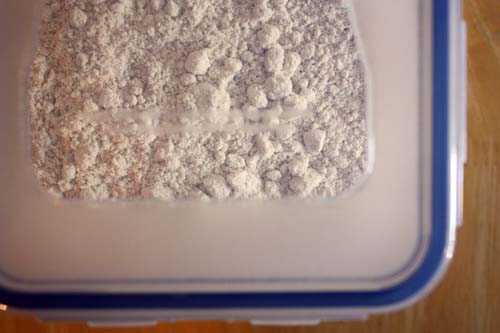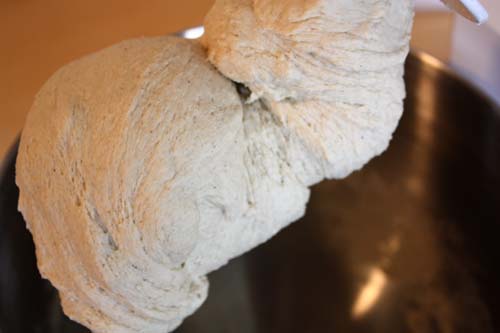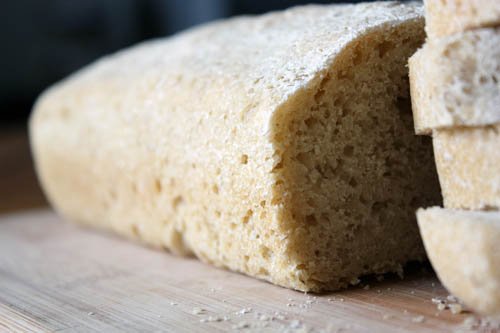Round Thirty Three — Oat Flour Bread

I’d noticed that I’ve been a little fancy lately with my recipes. Nothing over the top but, you know, none of those basic loaves. It’s just been a while.
So I thought I’d go back to a simpler time, when a handful of ingredients mixed together and left to rise makes the most amazing, tasteful bread on Earth.
Unfortunately, this is not one of those times.




You see, as you can tell by my life story (heavily abridged, of course), this blog is about both the good and the bad. The beautiful and the ugly. My triumphs and my failures. Some days we win, some, we lose. And I was one big loser this time around.
After all these months (nearly a year, actually, egads!) you’d think I’d know what makes a bread rise or not. Confession: I don’t. Luck, perhaps? A tiny plea for success? Crossing your fingers as you pour the yeast into the batter? Clicking your heels together before the bread is left to proof? In my short but adventurous bread baking experience, I still haven’t figured it out.
I know a few things. I know that warm water and room temperature ingredients help out a lot. I know it’s best to keep the yeast fresh, sealed and tucked in the back of the fridge. I know that sometimes, instant yeast is SO much easier to work with than active dry yeast. I know that putting the dough on top of the fridge seems to always help out the rise. Don’t ask me why. Don’t ask me how I know. I just know. You pick these things up along the way.
And yet… after knowing all those things, sometimes, a loaf will turn out as ugly as this one. Boring, lifeless, barely risen and with a hard-as-a-rock crust.


Was it old flour? Was it the fact that I put the dough in the fridge after the first rise because I was leaving to go camping for the weekend, and therefore had no time to wait for its second rise (though the directions stated clearly that the dough can be stored at this point for up to 10 days)? Was it cold yeast? Was it the fact that I thirded (yes, thirded, not halved) the ingredients and perhaps overly trusted my shoddy math? Who knows.

So here it is, folks. The seedy underbelly. The dark side of the bread baking world. A catastrophe. And yet, a tasty one at that. Because despite the hideousness of its exterior, the inside of this loaf is quite delicious. Well hand me a knife and slap me on some buttah, there is always a silver lining.
Debrief: I like to think this entire post was a debrief. I have no idea what went wrong here (I’m guessing it had something to do with the refrigeration, as that never seems to work well for me). Maybe you can venture on this recipe and let me know how it turns out for you.
Oat Flour Bread
Courtesy of Artisan Bread in Five Minutes a Day
(I’m going to give you the full version of the recipe in case my math was wrong, but, I did third this recipe because I have so many dang loaves in the fridge, the last thing I needed were triplets added to the bunch.)
Makes three 1 1/2-pound loaves. The recipe can easily be doubled or halved.
3 1/4 cups lukewarm water
1 1/2 tbsp granulated yeast (1 1/2 packets)
1 1/2 tbsp salt
1 cup oat flour, plus several tbsp extra to thicken the dough (about 3-5)
5 1/2 cups unbleached all-purpose flour
Cooking spray or oil for greasing the pan
Directions:
Mix the yeast and salt with the water in a large bowl. Set aside.
Mix the flours, without kneading, into a heavy duty stand mixer with the dough hook attached. Pour wet ingredients into dry ingredients and knead with dough hook until a soft and smooth dough forms and pulls away from the sides of the bowl, about 6 minutes (here is where the extra tbsp of oat flour may come in, depending on how sticky your dough is).
Place kneaded dough in a lightly greased bowl and cover and let rise until doubled, about 2 hours. The dough can be used immediately after the initial rise, though it is easier to handle when cold. Refrigerate in a lidded container and use over the next 10 days.
On baking day, lightly grease a 9 x 5-inch loaf pan. Dust the surface of the refrigerated dough with flour and cut off a 1 1/2-lb. (cantaloupe-size) piece. Dust the piece with more flour and shape it into a ball. Drop into the loaf pan. all to rest and rise for 1 hour and 40 minutes (or just 40 minutes if you’re using fresh, unrefrigerated dough).
Twenty minutes before baking, preheat the oven to 400 degrees F, with an empty broiler tray on a shelf below the bread. Place the loaf on a rack near the center of the oven and just above the broiler pan. Pour 1 cup of hot tap water into the broiler tray and quickly close the oven door. Bake for 45 minutes or until deeply browned and firm. Allow to cool before slicing or eating.

This line cracks me up: “Well hand me a knife and slap me on some buttah, there is always a silver lining.”
And as for the top of the fridge, I’d say because hot air rises, and therefore it’s a bit warmer there?
Yeah, I think I remember reading that’s the reason dough rises better on top of the fridge, but it kind of just turned into one of those “you keep doing because it works, but you’re not sure why” kind of things.
It’s warm on top of the fridge.
I halved the recipe and added about 1 Tbsp ground flax and 1/4 cup honey… Made 2 smaller sized loaves from this… Loved it! I have Artisan’s second book (healthy bread…) but not the first so I didn’t have this recipe! Thanks for sharing!
I have found that the best way to get bread to rise is to turn on the light in your oven (no heat) and put the dough in until it’s ready. Works great!
After following a recipe correctly, kneading before each time you let it set to rise is what makes bread rise. For a soft crust, butter the top with a pastry brush as soon as the bread comes out of the oven, before you take it out of the loaf pan.
My mother waws a home ec teacher & she always said the water you mix the yeast in should be luke warm (approx 100 deg) if you get it too hot it will kill the yeast, too cold won’t activate it. I believe it says on the pkg what the temp should be but haven’t baked bread in years due to arthritis. Just my 2 cents woth, but I hope it helps.
Very creative site name Steph haven’t baked bread since 81 but want to get away from wheat so will use oat and millet flour instead.
My husband was a baker and said salt kills yeast, so don’t add them at the same time.
The salt killed the yeast. Yeast needs to feed on sugar.
I would also say 1 1/2 tbs is way to much salt.